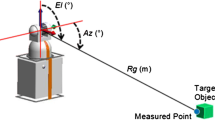Abstract
In this paper, a precision inspection technique using CAD/CAI integration is proposed for parts having very thin and sharply curved features. The technique begins with feature reconstruction of turbine blades which have combined geometry, such as splines, and thin small radius circles. The alignment procedures consists of two phases — rough and fine phases: the rough phase alignment is based on the conventional 6 points probing on the clear cut surfaces, and the fine phase alignment is based on the initial measurement of the curved parts using the least-squares technique based on iterative measurement feedback. For the analysis of profile tolerance of parts, the actual measured points are obtained by finding the closest points on the CAD geometry by the subdivision technique developed. The Tschebyscheff norm is applied iteratively, giving an accurate profile tolerance. The inspection technique developed is applied to practical blade manufacturing, and has demonstrated good performance.
Similar content being viewed by others
Abbreviations
- r i (u),r j (u):
-
3D vector curve representing theith,jth curve segment for spline
- u, ν :
-
parameters in [0, 1] representing curve
- P i ,P i+1 :
-
ith, (i+1)th control points on the spline curve along the airfoil direction
- Q j ,Q j+1 :
-
jth, (j+1)th control points on the spline curve along the vertical direction
- W i :
-
ratio of chord length to the previous chord length on the spline curve
- C(Cx, Cy):
-
centre coordinate of the edge circle
- θo, θ:
-
initial angle and range angle of the edge circle
- N jp ,N :
-
normal vector on the surface patch formed byP i ,P i+1,Q j ,Q j+1 control points
- A 1 toA 6 :
-
6 probing points for the rough phase alignment
- A 1 toA′6 :
-
contact points at the clear cut surface corresponding to theA 1 toA 6
- X′(a x,b x,c x),Y′(a y,b y,c y),Z′(a z,b z,c z):
-
base vectors for CAD coordinate system with respect to the CCM coordinate system
- O (O x,O y,O z):
-
origin of the workpiece in the CMM coordinate system
- D :
-
measurement target points of the workpiece
- r :
-
probe radius
- M :
-
coordinate measurement target points in the CMM coordinate system
- DM :
-
direction vector of the measurement target points in the CMM coordinate system
- T 1 :
-
transformation matrix of 4×4 for the rough phase alignment
- T 2 :
-
transformation matrix of 4×4 for the fine phase alignment
- MM, MM i :
-
measured data of the measurement target points
- Lp :
-
Tschebyscheff norm of powerP
References
N. Duffie, J. Bollinger, R. Piper and M. Kroneberg, “CAD directed inspection and error analysis using surface patch databases”,Annals of CIRP 33, pp. 347–350, 1984.
O. P. Bojanic, D. V. Majstrovic and R. V. Milacic, “CAD/CAI integration with special focus on complex surfaces”,Annals of CIRP 41, pp. 535–538, 1992.
C. H. Menq, H. T. Yau and G. W. Lai, “Automated precision measurement of surface profile in CAD directed inspection”,IEEE Transactions on Robotics and Automation 8(2), pp. 268–278, 1992.
H. J. Pahk, Y. H. Kim, Y. S. Hong and S. G. Kim, “Development of computer aided inspection system with CMM for integrated mold manufacturing”,Annals of CIRP 42, pp. 557–560, 1993.
G. Goch and U. Tschudi, “A universal algorithm for the alignment of sculptured surfaces”,Annals of CIRP 41, pp. 597–600, 1992.
Author information
Authors and Affiliations
Rights and permissions
About this article
Cite this article
Pahk, H.J., Ahn, W.J. Precision inspection system for aircraft parts having very thin features based on CAD/CAI integration. Int J Adv Manuf Technol 12, 442–449 (1996). https://doi.org/10.1007/BF01186933
Issue Date:
DOI: https://doi.org/10.1007/BF01186933




